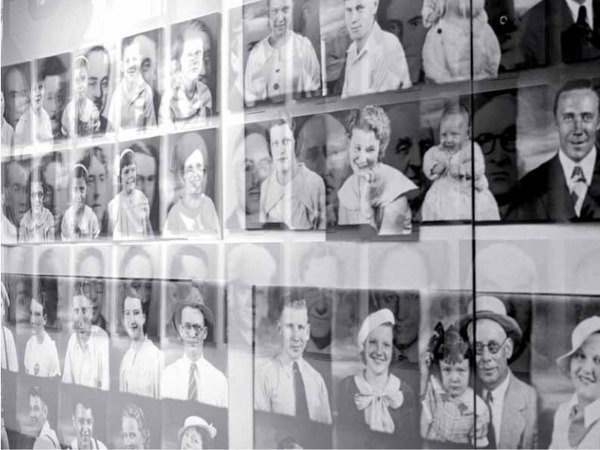Afteratlas
dal 21/1/2014 al 21/3/2014
Segnalato da
21/1/2014
Afteratlas
Beirut Art Center, Beirut
An exhibition conceived by French art historian and philosopher Georges Didi-Huberman and Paris-based, Austrian photographer Arno Gisinger. The idea of the exhibition is borne out of the limitations of moving large exhibitions of original artworks, like Atlas, to cultural institutions of different means in different parts of the world.

Beirut Art Center is pleased to present Afteratlas, an exhibition conceived by French art historian and philosopher Georges Didi-Huberman and Paris-based, Austrian photographer Arno Gisinger.
Afteratlas is a sequel to Atlas: How to Carry the World on One’s Back, an exhibition at the Museo Nacional Centro de Arte Reina Sofia in Madrid (2010) that was curated by Georges Didi-Huberman. The same exhibition was later presented at ZKM in Karlsruhe (2011) and Sammlung Falckenberg/Deichtorhallen in Hamburg (2011). Atlas was an attempt to understand and expose the artistic and thought process of 140 artists, writers, filmmakers, and theorists through their preparatory works and original oeuvres.
At Beirut Art Center, Afteratlas is the third edition of a post-Atlas collaboration between Didi-Huberman and Gisinger. It is a photographic essay that reacts to documentary photography; it consists of a conceptual montage of the Atlas exhibition at Sammlung Falckenberg. Earlier adaptations were presented at the Fresnoy studio national des arts contemporains (2012) and the Museu de Arte do Rio (2012). The idea of the exhibition is borne out of the limitations of moving large exhibitions of original artworks, like Atlas, to cultural institutions of different means in different parts of the world.
The post-Atlas series of exhibitions is a contemporary homage to Aby Warburg (1866-1929), a German art historian who created his own, incomplete atlas of images of artworks, Mnemosyne Atlas. In his assemblage in “constellations” he sought to explore new associations between different visual forms invented in different time-spaces, creating thus new, universal meanings of imaginings, desires, and affects.
The walls of the exhibition space at Beirut Art Center will be covered with 3.5 x 2.5 m images in poster format from Gisinger’s photomontage, including photographs of original artworks, bits of contracts, production images, reflections, surfaces, interactions. Excerpts from modern and contemporary cinematic productions arranged in thematic constellations by Georges Didi-Huberman will be projected on one of the walls of the center. A video consisting of a close-up travelling of Warburg’s Mnemosyne # 42 will be projected on another. Facing the photographs and the moving images on the wall, the viewer will first and foremost experience the overwhelming monumentality of the images, which is an altogether new form and different experience of the show.
The concept of a travelling, locally specific post-Atlas exhibition is itself inspired by Aby Warburg’s notion of Wanderung, a transhistorical migration of forms that acquire new meanings in different contexts. While there may be some overlap in content, each edition of the exhibition unfolds in a new form. At the Fresnoy, Gisinger’s photographs were printed in a smaller format, forming a “filmstrip” that revealed the exhibition space on the upper gallery; the ground floor, which could only be seen from the gallery above, became a projection screen for excerpts from cinematic productions. At the Museu de Arte do Rio a modified selection of Gisinger’s images was printed on wood, placed on the ground, and once more the viewer experienced the photographic constellations from above.
Afteratlas lays the ground for a discussion on the contemporary politics of art, its representation and exhibition, questioning Walter Benjamin’s “aura” in relation to Aby Warburg’s approach toward reproducing originals, creating photographic montages, and providing non-standard knowledge. In this locally specific edition, at once pragmatic and more Marxist in its approach, the viewer is invited to rethink the merit of Warburg, re-assess photography as a medium for its endless possibilities of rearrangements, intertextuality and aesthetical pleasure, and ultimately critically question what is inherent about the value of art.
Georges Didi-Huberman is a philosopher and art historian. He teaches at l’École des Hautes Études en Sciences Sociales (Paris). He has published over fifty works on the history and theory of the image since 1982. His most recent publications include L’Album de l’art à l’époque du « Musée imaginaire » (Hazan, 2013) and Phalènes. Essais sur l’apparition, 2 (Minuit, 2013). He has directed several exhibitions, including L’Empreinte (The Imprint) at Centre Georges Pompidou (Paris, 1997), Fables du lieu (Fables of a Place) at Fresnoy - studio national des Arts contemporains (Tourcoing, 2001), Atlas at the Museo Nacional Centro de Arte Reina Sofía (Madrid, 2010), and most recently Histoires de fantômes pour grandes personnes (Ghost Stories for Grown-ups) at the Fresnoy et at the Museu de Arte do Rio (Rio de Janeiro) co-curated with Arno Gisinger.
Arno Gisinger is an Austrian artist who lives in Paris. He is developing an artistic practice that ties photography and historiography together for studying the representation of the past by rethinking the status of the image in our contemporary societies. Since 2012 he has been leading two projects that experiment with the transformation of the image when it is confronted with a new exhibition space. In the first, Topoï, his major works are reconfigured in the spaces and times of four different exhibitions in Europe. Atlas, suite questions the complex relations between works of art and their photographic interpretations. Gisinger published several works on photography, history and fiction, most notably L’Ordinaire de l’oubli (Société française de photographie, 2001), Konstellation Benjamin (Transphotographic Press, 2009), and Topoï (Transphotographic Press, 2013). Arno Gisinger is an Assistant Professor at l’Université de Paris 8.
Image: Arno Gisinger, from the photographic series, Afteratlas, 2012, Nameless and Famous Men (Walker Evans, Gerhard Richter)
For more information and to schedule a tour, Cynthia Issa plz email cynthia.issa@beirutartcenter.org or call (01) 397- 018.
Opening reception: Wednesday January 22, from 6pm to 9pm
Beirut Art Center
Jsr El Wati - Off Corniche an Nahr. Building 13, Street 97, Zone 66 Adlieh. Beirut, Lebanon
Hours: Monday through Saturdays, 12:00 to 8:00 pm
Free entrance



